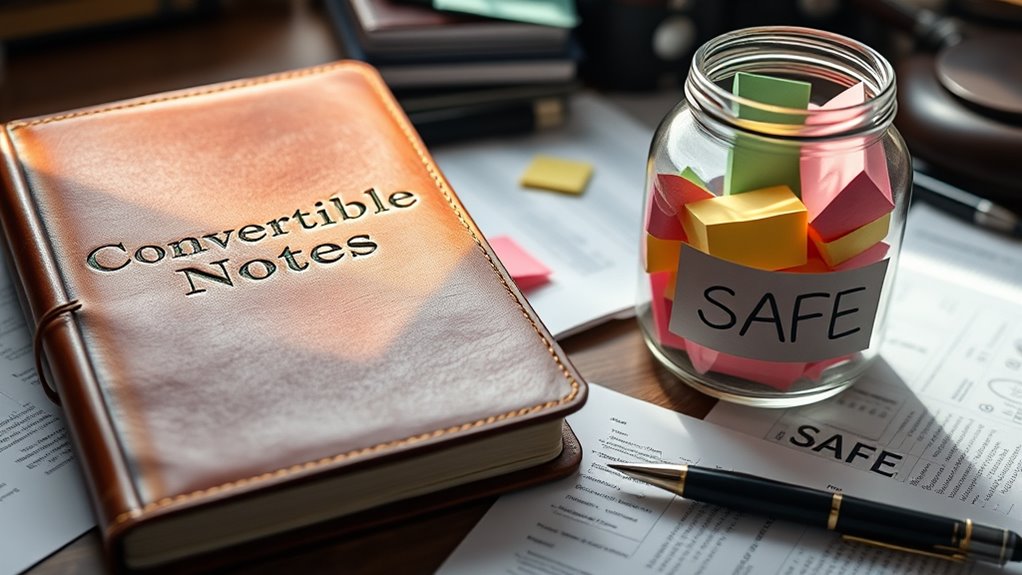When comparing convertible notes and SAFEs, founders often overlook legal issues like misunderstood valuation caps, which can cause excessive dilution or undervalue your company, or the debt obligations tied to convertible notes, including interest and repayment risks. SAFEs might seem simpler but can pose challenges if the company struggles to raise future funding. Recognizing these land mines helps you avoid costly mistakes—continue elsewhere to learn how to navigate these pitfalls effectively.
Key Takeaways
- Convertible notes are debt instruments with interest and maturity dates, risking repayment issues if not converted; SAFEs lack these features, simplifying legal terms.
- Misunderstanding valuation caps can lead to undervaluation or excessive dilution, causing legal disputes and financial loss for founders.
- Incorrectly negotiating or documenting these instruments may result in unexpected dilution, legal liabilities, or unfavorable conversion terms.
- Failing to clarify instrument specifics with investors can create legal conflicts and misunderstandings during subsequent funding rounds.
- Overlooking cybersecurity vulnerabilities in the fundraising process can expose startups to legal and financial risks.

When raising startup capital, understanding the differences between convertible notes and SAFEs is essential for founders and investors alike. These instruments are popular for their simplicity and speed but come with nuanced legal and financial implications. One key area where many founders stumble is understanding valuation caps. Valuation caps set a maximum company valuation at which your investors’ convertible instruments convert into equity, protecting early investors from excessive dilution if your company’s valuation skyrockets during future funding rounds. If you don’t negotiate or understand these caps properly, you risk undervaluing your company or diluting your ownership more than you expected. For founders, it’s vital to set a fair valuation cap that balances attracting early investment while preserving future equity for yourself and your team. On the other side, investors typically look for a favorable valuation cap to maximize their upside, especially if the company’s valuation exceeds the cap at the time of conversion. Additionally, understanding the legal distinctions between convertible notes and SAFEs can help you avoid pitfalls. Convertible notes are debt instruments that accrue interest and have a set maturity date, after which they must convert or be repaid. SAFEs, on the other hand, are not debt and don’t accrue interest or have a maturity date, making them simpler but potentially riskier for investors if the company struggles to raise subsequent funding. Knowing these differences helps you communicate clearly with investors and set accurate expectations. Recognizing cybersecurity vulnerabilities related to these instruments can also be important, especially as digital security becomes increasingly critical during fundraising processes.
Frequently Asked Questions
How Do Convertible Notes and SAFES Impact Future Funding Rounds?
When you use convertible notes or SAFEs, your future funding rounds are impacted through valuation caps and discount rates. These instruments convert into equity at a discount or capped valuation, which can dilute early investors and influence how new investors perceive your company’s worth. You’ll want to carefully set these terms to balance attracting initial funding with maintaining favorable conditions for future rounds.
Are There Specific Industries Where One Instrument Is Preferable?
Imagine each industry as a different terrain—some smooth, others rugged. In industry-specific funding, you’ll find that SAFEs often suit tech startups due to fewer regulatory hurdles, making rapid growth easier. Conversely, in industries like biotech or finance, convertible notes might be preferable because they offer clearer valuation terms and comply better with complex regulations. Choose your instrument based on your industry’s regulatory landscape and funding needs.
What Are Common Legal Pitfalls Founders Overlook With These Instruments?
When you consider legal pitfalls with convertible instruments, you often overlook issues like legal compliance and contract enforceability. You might assume standard terms are enough, but failure to address jurisdiction, valuation caps, or conversion triggers can lead to disputes. Always guarantee your agreements are clear, enforceable, and compliant with relevant laws. This proactive approach helps avoid costly legal challenges and ensures your investment terms hold up over time.
How Do Convertible Notes and SAFES Affect Ownership Dilution?
You might think that convertible notes and SAFEs don’t impact ownership, but research shows they do, especially with valuation caps and interest rates. When these instruments convert, they can profoundly dilute your ownership stake, often more than expected. Valuation caps set a maximum price for conversion, affecting how much equity you give up. Interest rates on convertible notes increase the amount of shares issued, further diluting your control during conversion.
Can Convertible Notes or SAFES Be Converted Into Different Types of Equity?
You might wonder if convertible notes or SAFEs can be converted into different types of equity. Yes, they offer some instrument flexibility, allowing for equity conversion into various classes like common or preferred stock. This flexibility helps align your fundraising strategies with your company’s growth. Just keep in mind that specific terms in your agreement will dictate the potential for different equity conversions, so review those carefully before proceeding.
Conclusion
Choosing between convertible notes and SAFEs is like walking a tightrope—you must weigh the risks carefully. While both can propel your startup forward, they come with legal land mines that could trip you up if you’re not careful. Don’t let hidden pitfalls catch you off guard; understanding these instruments is your safety net. Remember, in the startup world, knowledge isn’t just power—it’s your lifeline. Stay informed, stay protected, and keep your vision afloat.









